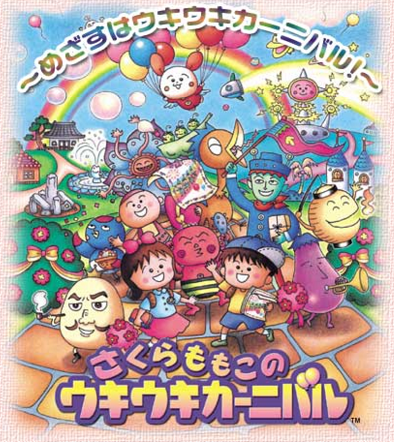
Introduction
Hi everyone, it's Melos here. A few months ago I played the 2002, Japan-only GBA game, Sakura Momoko no Ukiuki Carnival, a collaboration between indieszero, Nintendo, and Noriko Miura. I made a brief review of the game over at Backloggd: here. If you'd like to see or hear the game, there's a review at Michibiku and a playthrough on Youtube. There's also some nice music.
Overall, I think it's a brilliant game, although it seems to not have sold particularly well. Nintendo also still has the info website up for it - how fun! https://www.nintendo.co.jp/n08/aclj/index.html
In the game, you explore an "Internet" - characters have home pages, store have websites, and more. Clicking around or using the search engine with specific terms allows you to find info about items or characters that can advance you towards the goal of the game - inviting everyone to the town's annual carnival. It's a clever, streamlined and charming take on the early 2000's Japanese internet and personal blog culture, while also representing '70s Japanese Showa-era culture in a cartoony fashion.
My first encounter with the game was probably in 2018 or 2019 - my spouse grew up playing it and mentioned it as we were looking at her copy of Sennen Kazoku (Thousand-year family, a life-sim set in an apartment, by the Uki-uki devs.) Once we had moved to Japan I went to look for a copy of Uki-uki and picked up the guidebook and game at a local game store. (Sadly, almost immediately after I purchased Uki-uki, the store was shut down and replaced by a generic anime goods store. Such is the way of brick and mortar…)
Brief Sakura Momoko Note
The game's illustrations (not in-game sprites) are by Sakura Momoko, a famous Japanese manga artists, essayist and illustrator. I would say her popularity in Japan is similar to Banana Yoshimoto or Shigesato Itoi. While her work - such as Chibi Maruko-chan - is well-known in some asian countries like Taiwan, she's not that well-known in the English world. Only one of her essay books has been translated, "Momoko's Illustrated Book of Living Things". (You can check out my brief review if you're curious). I would say her greatest superpower is her ability to combine humor with memory and situations from childhood. I'm a fan of her 1990s work Coji-Coji - originally a 4-volume Japanese-only manga, but also a 100-episode anime. Parts of some episodes were dubbed in English if you're curious for a taste of its off-beat, fairy tale-esque elementary school setting humor: here . (For the record there's a brief transphobic section but I've found it's not indicative of the work as a whole)
Uki-Uki Carnival
Anyways, the main planner of Uki-Uki (creative director, scenario writer, lead designer) was Noriko Miura - who happens to be Sakura Momoko's older sister. Unfortunately this seems to be Miura's only foray into games… while I assume a translation of the game is out of the picture, a re-release in Japanese would be neat…
She did an interview with some other staff on Nintendo's website, which I've translated below. Enjoy! (...this is actually my first big translation. Wow! If anyone finds errors, let me know.)
The original interview is here: Here!
THE INTERVIEW
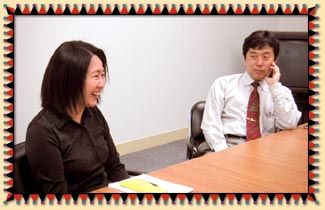
Sakura Momoko's Ukiuki Carnival: Development Staff Interview with Noriko Miura (三浦範子) and Toru Osawa (大澤徹)
(From Nintendo Online Magazine No. 47, June 2002.)
Person: Noriko Miura Profile: Age: late 30s or early 40s. Role: Planner and Scenario Writer. Older sister of manga artist Sakura Momoko.
Person: Toru Osawa Profile: Age ~40, Role: Nintendo SPD, Director of Planning and Development (企画開発課) Past works: Famicom Detective Club (1988, NES, Writing), Super Metroid (SNES, Object Designer, 1994), For the Frog the Bell Tolls (GB 1992, Director), Ocarina of Time (N64, 1998, Script Director)
"Internet" meets "Carnival"
(Interviewer) -- Miura-san, it was you who pitched the game, correct?
Miura: About 3 years ago, I made plans for what would lay the groundwork for the game. Thanks to a friend's intro, I was fortunate enough to propose it to Nintendo. I was so attached to my proposal, that I thought "If this gets rejected, I'll go out to the inaka and tighten screws in a factory."

-- What was the proposal like?
Osawa: From what I heard, at the start, the proposal that Miura-san showed us was pretty bare-bones - it barely had content that could be used for a game. What I heard was that since it couldn't be turned into a design document, and there weren't enough elements to make a judgment on, (Shigeru) Miyamoto replied "Could you try revising it again?"
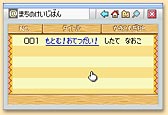
Miura: When I got my drafts back, (Takeshi) Tezuka-san was concerned about how the game's events would take place. I was so stuck on his feedback, thinking to myself, "If I just show the events like any other game, it'll be no good…", which eventually led to the system of using the message board and e-mail to handle events*. I was worrying about that how to show that in the game, and while browsing bulletin boards on my computer, I realized "Ah! We could make Home Pages!**
* Note: these italicized asterisks are notes from me (Melos), they weren't in the interview. In the game, you receive e-mails from other characters, often to mention some change in the game state - like a character having finished making something, or a new area opening. The message board is used to signpost the player towards a way to start a new main objective, in the form of requests from characters. While it sounds like it has the potential to be a real drag, there's actually fairly little to do at any given time so far so it never feels unmanageable.
**The word she uses is "ホームページ", literally "Home Page". I think the nuance is a little hard to capture in a single English word, so I translate dit literally - the websites in the game are usually (but not always) sort of like Geocities home pages? There's usually a top-level page that links to the character's thoughts, friends, interests. Anyways, her realization must be referring to the way that the large network of in-game websites eventually interact with the various quest systems in the game.
-- Have you worked as a game designer before?
Miura: Nope, I had a totally different career, jumping around between various jobs. Before making this game, I was the manager of a certain well-known manga artist.

Osawa: For Nintendo, since Miura-san was someone with no game development experience, from the start we thought that it might be inevitable she couldn't write a production-ready proposal. Maybe Miyamoto was even thinking "I wonder if she won't bother coming back…" Honestly, a lot of people give up at that stage. But about two months later, Miura-san came back with a much more fleshed-out proposal, full of detailed notes. Miyamoto, Tezuka, and the others were deeply moved by how far she'd come. They also thought that if the game leaned into those computer and internet mechanics, it could stand out from other existing games. It was at that point that I first heard about the game. During the proposal stage, we secretly showed it to internal development staff, and it was really well-received. From then on, meetings with Miura-san and the developers started, and finally, we arrived at the genre name of "Internet Gokko".*
* (Gokko = lit. "Make believe" (in the sense of "playing house"). I think it might also be a play on name of the tag-like children's game "Onigokko")
-- In your initial proposal, internet wasn't the main focus of the game, right?
Miura: Only up to the point of "Hm, it'd be fun to get an e-mail while playing a game" - most of the proposal focused on the carnival parts. From the start, on something like a bulletin board, everyone would post their problems and you'd go help them out. Because it was originally planned for the Game Boy Color, the game's mechanics were pretty simple. Later came the main concept - "A game where anyone can reach the ending." Even with games that are "easy", when it comes to someone like a 6-year-old girl, she might not be able to finish it! With that in mind, I set out to make a game where it'd be easy to get to the end. And if there was enough side content mixed in, I felt even a less casual gamer would be able to enjoy it, too.
Osawa: Miura-san, you play a lot of games, right?

Miura: Ahh, no - I'm not really the type who plays tons of games. Instead, maybe I'd have a game I really like, and play it 3 or 4 times. Like, in the Zelda series, I'd be really into finding all the Heart Pieces. But recently there haven't been many games I've wanted to play, which is why I decided I wanted to make some interesting game myself.*
* (Ah, the common way we all get into this industry…)
But, if my first game was too complicated, I doubt anyone would be able to understand it, and explaining it would be too hard… (laughs) So I decided to go with a game about organizing a carnival. Oh, and another thing - when I used to live in Shizuoka, I'd often like going to multiple festivals in one day. But since moving to Tokyo, the festivals are all huge and crowded, so I haven't really gone to any… with that in mind, I thought it'd be a lot of fun if I could take the idea of a simple and vibrant carnival, and realize it within a tiny game console.
-- When did you decide to use Sakura Momoko's characters?
Miura: When I was going to bring the proposal to Nintendo, I was thinking about all the people who'd play the game, and - that's when I made up my mind. I came up with the characters' background details. I'd make the character's personalities and traits, hand that over, and then, face-to-face, we'd nail down the final visual design.
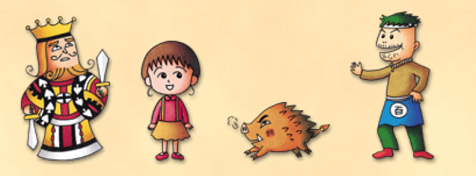
-- Was it easy to communicate because you were sisters?
Miura: No, not because of that… how should I put it… when it comes to how I design characters, I'm not overly fussy, like - "I NEED you to make it this way". As long as the main elements in the character's notes were included, I was fine with however it was drawn. In the end I didn't have any issues with the final illustrations.
-- How many characters are there in total?
Osawa: In total, there are XXX people* you can invite to the carnival. Since there's so many, if you only play once I think there'll still be a bunch left to invite.
*(There are about 120 or so? Some involve some pretty finicky luck minigames, so I couldn't 100% it…)
-- Wow, XXX characters!
Miura - Even so, we reduced the number. In pre-production, there were a lot more characters!*
*(The cutting room! The way of all games!)
Around 1500 pages in all. With Chat, Search Engines, and more!
-- The internet within the game is really its own whole thing! Did it have dedicated staff making it?

Osawa:
You use a computer called a "Minipa" for browsing the game's internet, but at the start there wasn't much content there, so we had the regular staff go and help out. But, we had a bunch of ideas like "If we're gonna go this far, we should add a search engine!" and "Hmm, it'd be nice if we could put some graphics in the Home Pages…" Since the number of webpages grew to around 1,500 pages, there ended up being a developer working full-time on it. He would always be working on it! When I'd come into work in the morning, he'd already be there and say "Good morning!" And when we'd go home, he'd still be there, sitting with the same posture, saying "Otsukaresamadeshita!" And the next morning… sitting exactly the same way, he'd say "Good morning!" again (laughs).
He was working so hard that I never figured out when he'd go home. One time, when he wasn't at work, I thought "Oh no! Something's happened!", but then he just showed up, saying "I forgot to set my alarm clock and overslept." Never got worse than that! (laughs)
-- The idea of searching for hints on the internet was pretty interesting.
Osawa: During the proposal stage, we'd only decided that you'd gather info on the internet, using it to progress through the game. It wasn't until we started making the game that the idea of following links - to search for hints - took form. It was easy to come up with the idea of triggering events through the message board and e-mail systems, but we were lost for a bit on how someone would use the Home Page system. But ultimately, Home Pages are something you'd have to search through with a goal in mind, right? So, finally, the search functionality was added.
-- I thought clicking on links felt similar to browsing the real Internet. While making the webpages, did you also add more links?
Osawa: Nope. The page connections had been planned from the start.* Otherwise, we wouldn't be able to estimate how much storage space they'd take up. Miura-san, you laid out the internet, right?
* (I'm actually pretty impressed by the discipline here, although it makes sense given it was made by a huge team… it's totally something that Marina and I would likely be, to some extent, changing as we go along.)

Miura: Yeah. In the start I laid out all of the links on paper in a flat diagram. Since some of the links led to the same pages, showing the links wasn't too hard.
Osawa: Miura-san, you memorized all of it, didn't you? Whenever someone would go "is this link right?", they'd ask you and you'd always know! You even wrote all the text for the websites.
-- So, you could say this game really expresses Miura-san's unique personality.
Osawa: Yeah, I think so. When she brought her revised proposal in, she'd already written which events characters would appear in and what they'd say. But, she was so passionate, that when we'd request revisions, she'd rarely budge! (laughs)
If you play it I think you'll understand how there's been no Nintendo game with this kind of writing style before. It's really got that "Noriko Miura charm."
-- As the original designer, did things go the way you'd imagined them?
Miura: Yeah! Within the programming aspects there were some small revisions, but I was surprised that when it came to big changes, there was no need for any huge cuts. We were able to make the game pretty close to how I had imagined it from the start. Also, I was happy about how much visual freedom being on the GBA gave us - at first, the decorations in the city weren't as flashy as they are now!* The GBA also made the search engine possible.
* In the final game, clearing the main quest in each of the eight small "city blocks" (or villages) causes it to be decorated in a fairly celebratory, festival or holiday-esque fashion. The music also changes to become more energetic.
A game with an air of nostalgia…
-- How many times do you have to play the game to see everything?
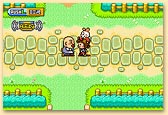
Osawa: Inviting everyone to the carnival will take a couple of playthroughs, but if you just want to see the ending, I think it'd take around 2 or 3 days. At first we thought kids would have trouble grasping the internet systems, but after some internal testing, we found that kids were able to figure out and get through the game faster than the adults. It didn't turn out to be the overcomplicated game we were worried about at the outset.
-- The idea of recycling showed up, and I felt it had some educational qualities to it. Was that intentional?
Miura: No, not particularly, but personally, I do like recycling. Things being reborn from unwanted goods - I think that's neat. The Monpi* are created from trash, which, for one, is kind of like recycling, and also kind of like that old custom of Hari-Kuyō **. Bringing items to the shrines was also like that.
* Monpi - Non-human NPCs in the game that are either humanoids, animals, or talking food/objects. I think there's some lore about them being reborn from unused goods. They are often more complicated to invite to the carnival (involving webpage games, branching chat games, etc), many only being able to be invited in the 2nd playthrough. ** See Wikipedia. . It's an old tradition where you place broken/old needles into soft things to honor them. Regarding the items at shrines, you always need to bring a special item (a CD, a red hat, etc) to the shrine deity at each of the town's shrines.
-- I thought it was nice how money never shows up.
Miura: Not being able to use money was one of the selling points we were going for - as well as being a game with no health, money, or fighting.

Osawa: After all, kids don't usually have a lot of money, right? For this game, we tried to give everything a touch of that 1970s atmosphere. Like, there weren't clothing stores yet - just tailors. Or the dagashi* stores. Even for shoe stores, they more often repaired shoes than sold them. While playing, I think adults will have a sense of nostalgia, while kids will get to experience something fresh.
*Small, independently-run candy stores that sold an assortment of cheap candy and toys. You can still find them here and there throughout Japan. For example, there's one at a shrine near me. For a rough approximation, imagine that you've walked into a gas station's candy section, but then replace the atmosphere with the Toys section of a museum gift shop… Anyways, most conbini in Japan have a small section with dagashi-like candy. I'm a fan of the "BIG CHOCO". It's this foot-long, puffed-corn-like bar covered in chocolate. There is also a "BIG KATSU", a fish-paste-based snack, which is not that big. Somehow - or, disturbingly - it actually tastes like pork katsu and tonkatsu sauce.
-- By the way, Miura-san - in Chibi Maruko-chan, Maruko's older sister often makes an appearance. In the manga, she's different from Maruko - she's the studious type, always studiously doing her homework.
Osawa: This time, for game-making, she really aced her homework!

Miura: Yeah but, others have said stuff like "It's Miura's fault that the release got delayed…", right? (Laughs) But, homework is homework, and business is business - they're totally different things, right?
-- Will you keep making games?
Miura - I have a lot of ideas I want to make, so if they let me, I'd want to do another one. There's a bunch of old ideas scattered all over my house! I've always wanted to work with Nintendo, and I was really pleased with how this project turned out.
(end of interview)
Unfortunately, as of writing, Noriko Miura did not make another game. Honestly I was sort of disappointed to find this out but there's a million reasons it could have been the case… One reason is probably sales? It's hard to tell how well it sold, but probably not well since it never got localized. It's fairly easy to find cheap copies on amazon japan, though. A quick search pulls up a 5chan(?) thread which shows Uki-uki having sold 5000 copies in the first week (or day), which, if true, is depressingly poor.
If I had to speculate, it is still a bit of a hard sell of a concept. For one, it reads like a girl's game (perhaps further due to the association with Sakura Momoko?), even though it is more of a general kids' game with all-ages appeal. Thus I suspect it might not have reached all of its audience. And on top of that, it probably looks complicated from the back, with a lot of reading? Even though it's fairly simple to play. Well, it certainly wouldn't be the first time in history that a game's gotten a bad shake. Thankfully, we can still enjoy it to this day!
I'd love to interview Miura or Osawa about this game (and the aftermath), of course, I have no idea where I'd track down Sakura Momoko's sister or a senior Nintendo employee. If you have any leads… hello@analgesic.productions .